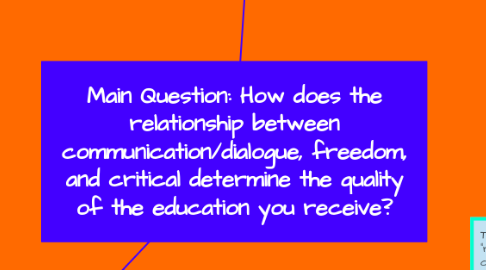Main Question: How does the relationship between communication/dialogue, freedom, and critical determine the quality of the education you receive?
by Alexandra Pinkowski

1. Education isn’t about getting a degree and a well-paid job; it’s about learning to be a better human being.
2. “Problem posing education, which breaks the vertical patterns characteristic of banking education, can fulfill its function as the practice of freedom” (67).
3. The problem-posing education is “responding to the essence of consciousness - intentionality- rejects communiques and embodies communication” (66).
4. Students learn by developing their analytical intellectual powers.
5. Wallace argues that it is important to make choices that create a life full of understanding and love. For one to do this, they must learn that becoming educated creates the ability to make decisions and choices in life.
6. “Work is often evaluated not according to whether it is right or wrong, but according to whether the children followed the steps right” (73). Anyon's argument is that children have a difficult time learning in working class schools because of the habitual and mechanical repetition of the learning process.
7. In today’s society, a very common relationship exists; teacher-student. This relationship involves a narrative character, in this case the teacher, who regurgitates information for the students to listen to. The information becomes “lifeless and petrifies” (57) as this model suffers from narration sickness.
8. Students of these families learn through working creatively and independently.
9. What is freedom (in the context of education)? and why is it important?
10. Why is a quality education important? (and how is it different from a non-quality education--what is non-quality education)?
11. What is the connection between these three things when it comes to getting a quality education?
12. What difference does it make to have a quality education? For ourselves as individuals? For society as a whole?
13. Empathizing with other people allows us to think beyond ourselves and think about our thinking. It expands our worldview to include ourselves and others from a less obstructed angle. Viewing things more objectively helps us to understand our own actions as well as others’.
14. It is such a blessing, language, to be able to communicate with another when they’re in need of something.
15. Education
16. "He must be a partner of the students in his relations with them" (62).
17. These students learn from getting the right answer. Getting the right answer by following directions, allowing some choice, some figuring out, and some decision making.
18. The teacher will connect concepts of different materials so the students can learn to also connect concepts on their own.
19. In order to accomplish liberation, one must communicate.
20. The freedom of a person must be learned by someone, and that must be done through the problem-posing education. Where the student and teacher collaborate with one another.
21. A good humanist teacher works together with their students. Their ideas, questions, intentions all correspond together.
22. A parent educates their children by communicating with them. If their child comes up to them with a question that they have been pondering about lately, the parent would immediately answer them with love and support.
23. Historical vocation is communication with people to create a transformation of the position of teachers, students, and everyone around the world.
24. The problem-posing education is "responding to the essence of consciousness -intentionally- rejects communiques and embodies communication" (66).
25. Sugata Mitra elaborates on the topic of ‘the grandmother,’ and describes the grandmother nurturing the students when they perform something on the computer.
26. Paulo Freire and Jean Anyon demonstrate similar ideas in their books, such as the importance of asking the question “why,” and the importance of communication between students and teachers.
27. Teachers give the students the time and opportunity to try to answer questions on their own, but if they can’t, the teacher will explain to them the “why” question during the explanation at the front of the class.
28. The ideology of the liberal argument type of literacy is geared towards teaching students to write, allowing students to excel in their education.
29. Hope provides human equilibrium; the alleviation of all distractions and possible inhibiting factors, leaves communication pure and whole.
30. Shared thoughts and opinions help to make individuals expand their view of what is possible and so they begin to think deeper to fully understand their question or topic.
31. What is critical thinking? Why is it important?
32. Morrison argues that language or way of communicating that obscures the uniqueness or vulnerability of an individual can be classified as dead language.
33. Language can be interpreted in such a way that humans use that allows society to function, people to collaborate, children to understand, etc.
34. What is communication/dialogue (in the context of education)? and why is it important/significant?
35. Communication


